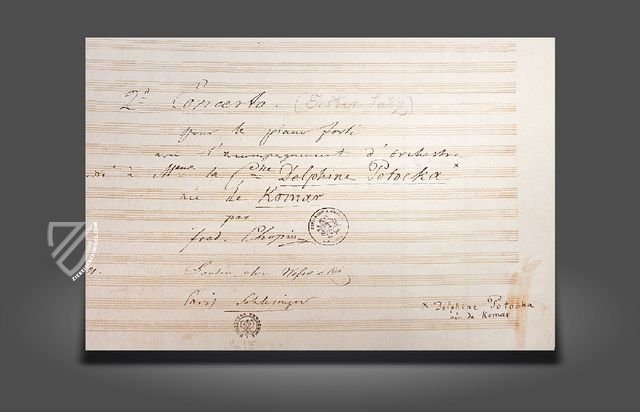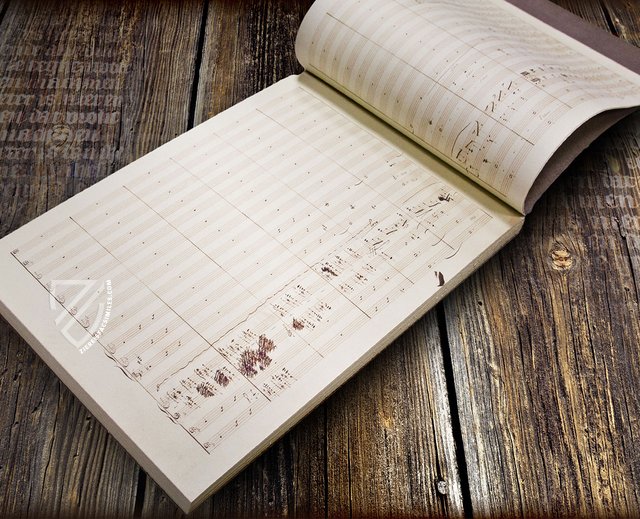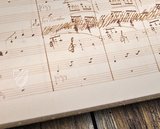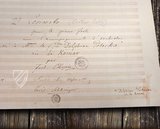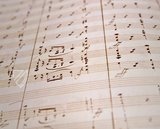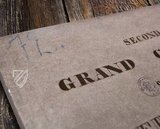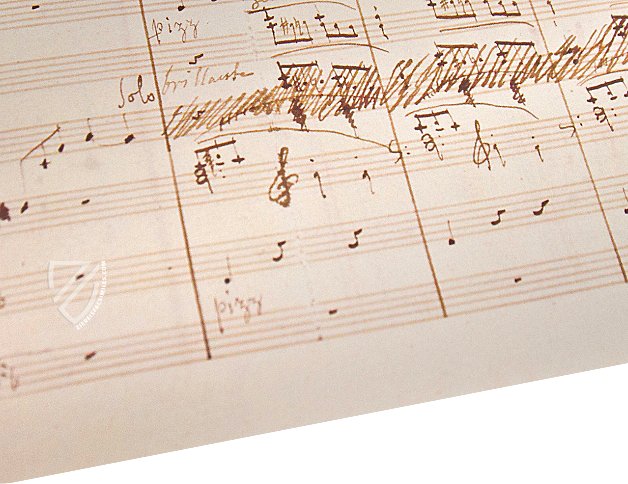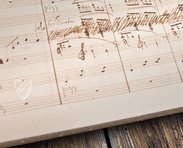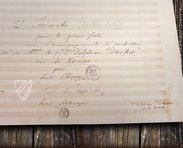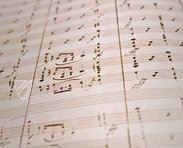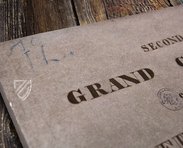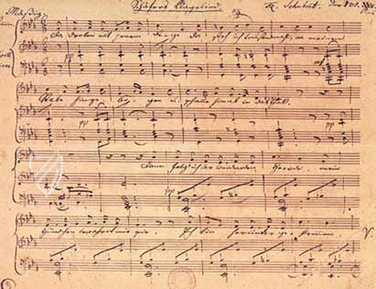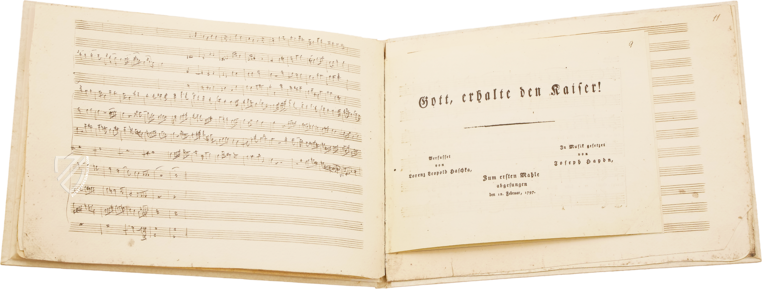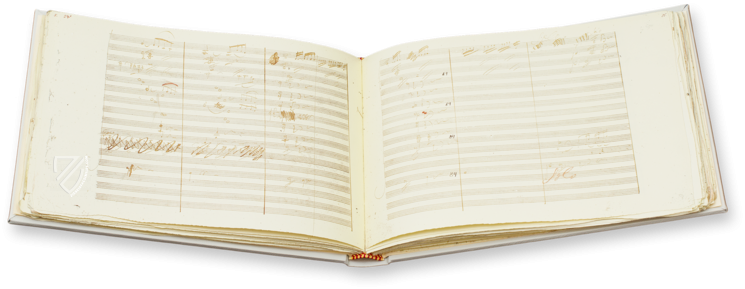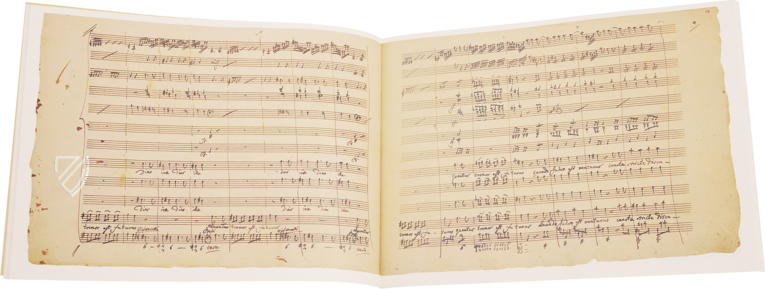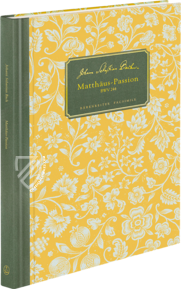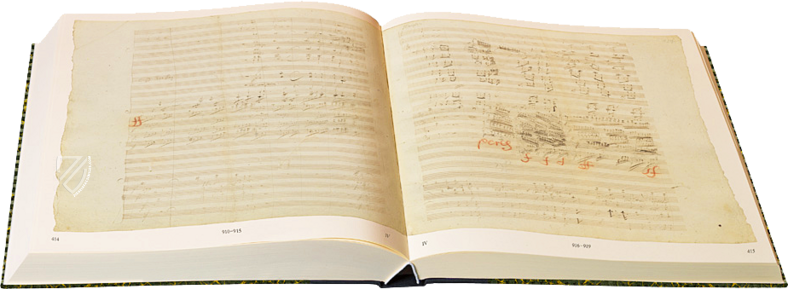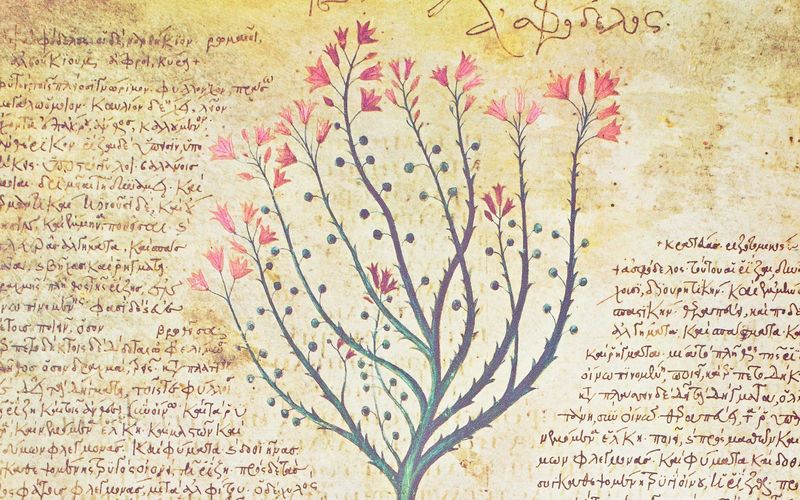Frédéric Chopin - Concerto in f-minor
(under 1,000€)
Although it is counted as Piano Concerto No. 2, the Concerto in F minor presented here is the first piano concerto composed by Frédéric Chopin (1810-1849). It was written shortly after he finished his music studies, when the composer was not quite 20 years old. Chopin was inspired to compose it by his first great love, the opera singer Konstancja Gladkowska. The premiere on the 17th of March 1830 at the National Theater in Warsaw took place in front of a sold-out audience, was a great success, and raised high hopes for the emerging career of the still young composer. The autograph was able to be taken out of the country during the German invasion of Poland in September 1939 and thus saved, whereas many other Chopin manuscripts were lost or destroyed during World War II.
Concerto in F minor - First Reception
The work was created between October 1829 and February 1830, when Chopin was around 20 years old. The full name of the piece is Piano Concerto No. 2 in F minor, Op. 21, indicating that this is Chopin’s twenty first composition (from the Latin opus – “work”). The first composer to use this designation was Biagio Marini (1617), while Ludwig van Beethoven was the first to use the opus number in a systematic manner. Although Chopin’s Concert in F minor was composed before the Concerto in E minor (though in the same year), it is called the second one due to the higher opus number. The Concert in E minor was published in 1833 in Paris and Leipzig and the F minor only in 1836. Both concerts are the first significant pieces composed by Chopin after he completed his musical studies. They were first presented in Chopin’s’ sitting room in the Krasiński Palace (orchestral parts were then organized for chamber ensembles), to the elite of musical Warsaw and the closest friends and family of the composer, and later to a broader audience on the scene of the National Theater in Warsaw. The rehearsal in the sitting room was held on March 3rd, 1830 and the long-awaited premiere (a sell-out by all accounts) of the Concerto in F minor on March 17th, 1830. Solo parts were played by the composer himself and the orchestra was directed by Karol Kurpiński.
An Instant Success
The concert was met with an enthusiastic reception of the audience and critics alike. Maurycy Mochnacki in the Polish Courier wrote: the adagio in Mr. Chopin’s concert is a unique work of an extraordinary musical genius. Indeed! He who starts so young, will make his name known far and wide. The second concert was held in the National Theatre already on March 22nd. During the performance, Chopin was displeased with the tone of his piano and decided to change the instrument. The new piano, this time to the composer’s full satisfaction, was provided by a Russian general, Diakov. During the second concert, apart from the above mentioned piece, Chopin also played Rondo à la Krakowiak and improvised during the encores. The artist was strongly urged to give a third concert, but was busy working on new pieces and tired with the praise that he considered exaggerated.
Chopin's Brilliant Composition
The Concerto in F minor was composed in accordance with the brilliant conventions of the genre introduced by Mozart, though adopted by Chopin directly from Johann Nepomuk Hummel. It was a style of piano music popular in the first half of the 19th century. However, Chopin, in both his concertos, took the style to its apogee, infusing it with the new, Romantic dimension. The concerto is split into three movements: I Maestoso in F minor, II Larghetto in a key relative to F minor, i.e. A-flat, and III Allegro vivace in F minor. The first of these movements is composed as a sonata with double exposure: the piece is first played by the orchestra, and later by the soloist where the solo part is much more elaborate. The second movement of the concerto, which is a nocturne, plays a significant part in the composition. The final of the concerto, played as a rondo, features motifs inspired by Polish folk dances. It exhibits the elements of the Polish mazurek and kujawiak. In the third movement, the violins play col legno (which means by striking the string with the stick of the bow) and accompany the piano playing the melody of the mazurka. Some accuse the composer of failure to achieve balance between the orchestra part and the solo piano part which is slightly longer. However, we have to bear in mind that Frederic was just shy of 21 years at the time and had no prior experience with an orchestra. However, the sheer excellence of the piano parts more than makes up for this imbalance – this is attested by the fact that arguably every significant pianist has this concerto in his repertoire.
Real Romantic Piece
Chopin’s piece became the starting point for the Romantic concerto. As Chopin openly admitted in his letters to his friend, Tytus Woyciechowski, this piece was inspired by his feelings for Konstancja Gładkowska, a singer. “Because I, maybe luckily, already have my ideal, whom I faithfully, though silently, have been serving for the last six months, whom I dream of, in whose memory I have composed the adagio for my Concerto...” – this is what the composer wrote in his letter to his friend on October 3rd, 1829. Konstancja met Chopin on April 21st, 1829, during a concert of the soloists of the Warsaw conservatory, where she was learning to sing tutored by Carlo Soliva. She was Chopin’s first love, though their relationship only lasted 18 months and ended after Chopin left for Paris – she and Chopin corresponded for another year, only to ultimately lose all contact. The Concerto in F minor published only in 1836 was dedicated to Delfina Potocka, just as the presented edition autograph from 1830. Delfina Potocka, dubbed the muse of Polish romanticism, was a long-time friend of Chopin. She met him in Dresden in 1830, probably in her mother’s house, and in 1832 she settled in Paris were she became a pupil of the composer. Their close relations often fueled gossip regarding their alleged love affair – in mid–20th century love letters to support this claim were even manufactured.
Chopin’s Only Semi-Autograph
The work was preceded by a draft made on grey-green paper with 14 staffs per page, text on 1-4 staff. It contains a few bars of the solo figuration and a few bars of the piano transcription of the orchestra part. The concerto in question was commemorated by Chopin himself on a semi-autograph in 1830, before it was officially printed. It was partially written down by the composer, and partially by an unknown copyist. The great Polish artist wrote down the solo part, the piano transcription and the title page: 2d Concerto. / pour le pianoforté / avec l’'accompagnement d’orchestre / dediés à Mme la Csse Delphine Potocka / née de Komar / par / Fred. Chopin / Op. 21. / Paris Schlesinger, i.e. “Second piano concerto with orchestra accompaniment, dedicated to Countess Delfina Potocka née Komar, by Frederic Chopin, opus 21, Paris Schlesinger”. The Schlesingers ran a publishing house in Paris – the semi-autograph was intended for this very Parisian publisher, but in time it became the property of the Breitkopf & Härtel publishing house from Leipzig, hence the numerous black and round seals from its German archive. The semi-autograph was written on cream-colored vat paper with a watermark, produced by the French Blacons paper mill, with 16 staffs per page. It has 87 leaves, i.e. 72 pages. This manuscript is Chopin’s only semi-autograph of that size and such musical significance.
Through the Tough Times
The Concerto in F minor made its way to the collection of the National Library at the beginning of 1938 when it was donated by the Ministry of Denominations and Public Enlightenment along with a collection of Chopin’s other autographs and copies. The entire collection was purchased by the Polish government in 1937 from the Breitkopf & Härtel publishing house. In September 1939, during the German offensive, Poles, taught by the bitter experience of the Swedish Deluge (to this day, Swedish churches and museums are adorned with Polish works of art), took the valuable manuscript along with the entire collection of Chopin’s works out of Poland. The collection was first moved to London, the seat of the Polish government in exile, and then to Canada, where it was safely stored in a branch of the Bank of Montreal in Ottawa. The semi-autograph of the Concerto in F minor returned to Poland only in 1959, twenty years after it had left the country. It is currently stored in the collection of musical manuscripts of the National Library, among 20 other autographs and edition copies of Frederic Chopin. Unfortunately, other manuscripts of the composer were irretrievably lost or destroyed in the course of the war.
Codicology
- Alternative Titles
- Fryderyk Chopin, Koncert f-moll
Frédéric Chopin - Konzert in f-Moll
Frédéric Chopin - Klavierkonzert Nr. 2
Fryderyk Chopin, Piano Concerto No.2, in F minor, Op.21 - Type
- Manuscript on paper
- Size / Format
- 174 pages / 34.5 × 24.8 cm
- Origin
- Poland
- Date
- 1829–1830
- Epochs
- Style
- Genre
- Language
- Artist / School
- Frédéric Chopin (1810–49)
- Previous Owners
- Breitkopf & Härtel Publishing House (Leipzig, Germany)
#1 Fryderyk Chopin - Koncert f-moll
Languages: Polish, English, German, French, Spanish, Japanese
(under 1,000€)
#2 Fryderyk Chopin - Koncert f-moll
Languages: Polish, English, German, French, Spanish, Japanese
(under 1,000€)
#3 Fryderyk Chopin, Piano Concerto No.2, in F minor, Op.21
Language: Japanese
(under 1,000€)
- Treatises / Secular Books
- Apocalypses / Beatus
- Astronomy / Astrology
- Bestiaries
- Bibles / Gospels
- Chronicles / History / Law
- Geography / Maps
- Saints' Lives
- Islam / Oriental
- Judaism / Hebrew
- Single Leaf Collections
- Leonardo da Vinci
- Literature / Poetry
- Liturgical Manuscripts
- Medicine / Botany / Alchemy
- Music
- Mythology / Prophecies
- Psalters
- Other Religious Books
- Games / Hunting
- Private Devotion Books
- Other Genres
- Afghanistan
- Armenia
- Austria
- Belgium
- Belize
- Bosnia and Herzegovina
- China
- Colombia
- Costa Rica
- Croatia
- Cyprus
- Czech Republic
- Denmark
- Egypt
- El Salvador
- Ethiopia
- France
- Germany
- Greece
- Guatemala
- Honduras
- Hungary
- India
- Iran
- Iraq
- Israel
- Italy
- Japan
- Jordan
- Kazakhstan
- Kyrgyzstan
- Lebanon
- Liechtenstein
- Luxembourg
- Mexico
- Morocco
- Netherlands
- Palestine
- Panama
- Peru
- Poland
- Portugal
- Romania
- Russia
- Serbia
- Spain
- Sri Lanka
- Sweden
- Switzerland
- Syria
- Tajikistan
- Turkey
- Turkmenistan
- Ukraine
- United Kingdom
- United States
- Uzbekistan
- Vatican City
- A. Oosthoek, van Holkema & Warendorf
- Aboca Museum
- Ajuntament de Valencia
- Akademie Verlag
- Akademische Druck- u. Verlagsanstalt (ADEVA)
- Aldo Ausilio Editore - Bottega d’Erasmo
- Alecto Historical Editions
- Alkuin Verlag
- Almqvist & Wiksell
- Amilcare Pizzi
- Andreas & Andreas Verlagsbuchhandlung
- Archa 90
- Archiv Verlag
- Archivi Edizioni
- Arnold Verlag
- ARS
- Ars Magna
- ArtCodex
- AyN Ediciones
- Azimuth Editions
- Badenia Verlag
- Bärenreiter-Verlag
- Belser Verlag
- Belser Verlag / WK Wertkontor
- Benziger Verlag
- Bernardinum Wydawnictwo
- BiblioGemma
- Biblioteca Apostolica Vaticana (Vaticanstadt, Vaticanstadt)
- Bibliotheca Palatina Faksimile Verlag
- Bibliotheca Rara
- Boydell & Brewer
- Bramante Edizioni
- Bredius Genootschap
- Brepols Publishers
- British Library
- C. Weckesser
- Caixa Catalunya
- Canesi
- CAPSA, Ars Scriptoria
- Caratzas Brothers, Publishers
- Carus Verlag
- Casamassima Libri
- Centrum Cartographie Verlag GmbH
- Chavane Verlag
- Christian Brandstätter Verlag
- Circulo Cientifico
- Club Bibliófilo Versol
- Club du Livre
- CM Editores
- Collegium Graphicum
- Collezione Apocrifa Da Vinci
- Comissão Nacional para as Comemorações dos Descobrimentos Portugueses
- Coron Verlag
- Corvina
- CTHS
- D. S. Brewer
- Damon
- De Agostini/UTET
- De Nederlandsche Boekhandel
- De Schutter
- Deuschle & Stemmle
- Deutscher Verlag für Kunstwissenschaft
- DIAMM
- Droz
- E. Schreiber Graphische Kunstanstalten
- Ediciones Boreal
- Ediciones Grial
- Ediclube
- Edições Inapa
- Edilan
- Editalia
- Edition Deuschle
- Edition Georg Popp
- Edition Leipzig
- Edition Libri Illustri
- Editiones Reales Sitios S. L.
- Éditions de l'Oiseau Lyre
- Editions Medicina Rara
- Editorial Casariego
- Editorial Mintzoa
- Editrice Antenore
- Editrice Velar
- Edizioni Edison
- Egeria, S.L.
- Eikon Editores
- Electa
- Emery Walker Limited
- Enciclopèdia Catalana
- Eos-Verlag
- Ephesus Publishing
- Ernst Battenberg
- Eugrammia Press
- Extraordinary Editions
- Fackelverlag
- Facsimila Art & Edition
- Facsimile Editions Ltd.
- Facsimilia Art & Edition Ebert KG
- Faksimile Verlag
- Feuermann Verlag
- Folger Shakespeare Library
- Franco Cosimo Panini Editore
- Friedrich Wittig Verlag
- Fundación Hullera Vasco-Leonesa
- G. Braziller
- Gabriele Mazzotta Editore
- Gebr. Mann Verlag
- Gesellschaft für graphische Industrie
- Getty Research Institute
- Giovanni Domenico de Rossi
- Giunti Editore
- Graffiti
- Grafica European Center of Fine Arts
- Guido Pressler
- Guillermo Blazquez
- Gustav Kiepenheuer
- H. N. Abrams
- Harrassowitz
- Harvard University Press
- Helikon
- Hendrickson Publishers
- Henning Oppermann
- Herder Verlag
- Hes & De Graaf Publishers
- Hoepli
- Holbein-Verlag
- Houghton Library
- Hugo Schmidt Verlag
- Idion Verlag
- Il Bulino, edizioni d'arte
- ILte
- Imago
- Insel Verlag
- Insel-Verlag Anton Kippenberger
- Instituto de Estudios Altoaragoneses
- Instituto Nacional de Antropología e Historia
- Introligatornia Budnik Jerzy
- Istituto dell'Enciclopedia Italiana - Treccani
- Istituto Ellenico di Studi Bizantini e Postbizantini
- Istituto Geografico De Agostini
- Istituto Poligrafico e Zecca dello Stato
- Italarte Art Establishments
- Jan Thorbecke Verlag
- Johnson Reprint Corporation
- Josef Stocker
- Josef Stocker-Schmid
- Jugoslavija
- Karl W. Hiersemann
- Kasper Straube
- Kaydeda Ediciones
- Kindler Verlag / Coron Verlag
- Kodansha International Ltd.
- Konrad Kölbl Verlag
- Kurt Wolff Verlag
- La Liberia dello Stato
- La Linea Editrice
- La Meta Editore
- Lambert Schneider
- Landeskreditbank Baden-Württemberg
- Leo S. Olschki
- Les Incunables
- Liber Artis
- Library of Congress
- Libreria Musicale Italiana
- Lichtdruck
- Lito Immagine Editore
- Lumen Artis
- Lund Humphries
- M. Moleiro Editor
- Maison des Sciences de l'homme et de la société de Poitiers
- Manuscriptum
- Martinus Nijhoff
- Maruzen-Yushodo Co. Ltd.
- MASA
- Massada Publishers
- McGraw-Hill
- Metropolitan Museum of Art
- Militos
- Millennium Liber
- Müller & Schindler
- Nahar - Stavit
- Nahar and Steimatzky
- National Library of Wales
- Neri Pozza
- Nova Charta
- Oceanum Verlag
- Odeon
- Orbis Mediaevalis
- Orbis Pictus
- Österreichische Staatsdruckerei
- Oxford University Press
- Pageant Books
- Parzellers Buchverlag
- Patrimonio Ediciones
- Pattloch Verlag
- PIAF
- Pieper Verlag
- Plon-Nourrit et cie
- Poligrafiche Bolis
- Presses Universitaires de Strasbourg
- Prestel Verlag
- Princeton University Press
- Prisma Verlag
- Priuli & Verlucca, editori
- Pro Sport Verlag
- Propyläen Verlag
- Pytheas Books
- Quaternio Verlag Luzern
- Reales Sitios
- Recht-Verlag
- Reichert Verlag
- Reichsdruckerei
- Reprint Verlag
- Riehn & Reusch
- Roberto Vattori Editore
- Rosenkilde and Bagger
- Roxburghe Club
- Salerno Editrice
- Saltellus Press
- Sandoz
- Sarajevo Svjetlost
- Schöck ArtPrint Kft.
- Schulsinger Brothers
- Scolar Press
- Scrinium
- Scripta Maneant
- Scriptorium
- Shazar
- Siloé, arte y bibliofilia
- SISMEL - Edizioni del Galluzzo
- Sociedad Mexicana de Antropología
- Société des Bibliophiles & Iconophiles de Belgique
- Soncin Publishing
- Sorli Ediciones
- Stainer and Bell
- Studer
- Styria Verlag
- Sumptibus Pragopress
- Szegedi Tudomànyegyetem
- Taberna Libraria
- Tarshish Books
- Taschen
- Tempus Libri
- Testimonio Compañía Editorial
- Thames and Hudson
- The Clear Vue Publishing Partnership Limited
- The Facsimile Codex
- The Folio Society
- The Marquess of Normanby
- The Richard III and Yorkist History Trust
- Tip.Le.Co
- TouchArt
- TREC Publishing House
- TRI Publishing Co.
- Trident Editore
- Tuliba Collection
- Typis Regiae Officinae Polygraphicae
- Union Verlag Berlin
- Universidad de Granada
- University of California Press
- University of Chicago Press
- Urs Graf
- Vallecchi
- Van Wijnen
- VCH, Acta Humaniora
- VDI Verlag
- VEB Deutscher Verlag für Musik
- Verlag Anton Pustet / Andreas Verlag
- Verlag Bibliophile Drucke Josef Stocker
- Verlag der Münchner Drucke
- Verlag für Regionalgeschichte
- Verlag Styria
- Vicent Garcia Editores
- W. Turnowski Ltd.
- W. Turnowsky
- Waanders Printers
- Wiener Mechitharisten-Congregation (Wien, Österreich)
- Wissenschaftliche Buchgesellschaft
- Wissenschaftliche Verlagsgesellschaft
- Wydawnictwo Dolnoslaskie
- Xuntanza Editorial
- Zakład Narodowy
- Zollikofer AG

